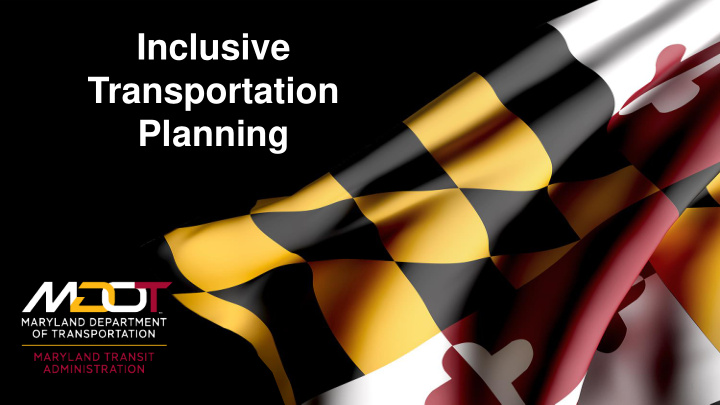



Inclusive Transportation Planning 1
What the project will do Increase participation in transit planning efforts by older adults and people with disabilities Making sure accessibility is incorporated early into project development Providing evidence of actions taken by MTA in response to received comments Coordinating participation with state-level agencies such as MDOD, MDoA, and DHCD, as well as transportation sub- committees 2
3
Project Deliverables Increase public engagement in transportation planning by improving the understanding and satisfaction of transit customers, especially older adults and people with disabilities, to: BY THE NUMBERS Build capacity 300+ older adults/people with disabilities directly The project steering committee, made up of staff from all three state agencies, nonprofits, advocates, and citizens, planned and conducted outreach specifically engaged for people with disabilities and older adults; developed a framework for more inclusive meeting locations and structures; and, opened the door to continuing 6 Participant-led partnerships in the arena of coordinated transportation. outreach events Produce knowledge Participant-led outreach activities intentionally built relationships between a 400+ collected broad spectrum of stakeholders and MDOT MTA as the region’s primary public observations on MDOT transportation provider; grant activities networked across disciplines and MTA transit experience agencies; and, project participants experimented with new tactics for engaging people where they were, rather than making them always come to the agency. 4 station wayfinding Make change prototypes in The project team gathered data and comments to develop tangible products development that responded to participants’ insights. 4
5
Project Approach Guiding Principles Human-centered The project team made a concerted effort to prioritize the lived experience of participants through research and collaboration with team members from different backgrounds. Project team members worked to meet people where they were so that community members could speak directly with those working on the project. This meant providing a variety of ways for people to find out about the project, ask questions, and offer their perspective on proposed plans. Open-ended MDOT MTA worked through the project steering committee and local Centers for Independent Living to encourage participants to take the lead in organizing outreach events. Moreover, MDOT MTA Office of Planning staff entered the project development process without a final product already in mind, enabling the project to adapt and change as participants directed. Action-oriented MDOT MTA intentionally identified wayfinding as a potential focus area because it aligned with an already ongoing MTA project that was open to participant input. 6
7
Engagement Outcomes: what we learned From FOCUS GROUPS we learned: How to convene participants in focused discussion Leveraging our partnership with The Image Center and Accessible Resources for Independence taught us the value of using a third-party facilitator for delivering honest conversations with existing fixed-route and paratransit customers From STATION WALK AUDITS we learned: How to layer infrastructure cues for older adults and people with disabilities Conducting in-person walk-throughs with project participants showed us how customers use multiple sensory cues (visual, auditory, tactile, and even olfactory) to help orient themselves From TABLING we learned: How to encourage more relevant feedback from older adults and people with disabilities Positioning ourselves at an established location for resource tables at the VA hospital reduced barriers to participation From the STEERING COMMITTEE we learned: We don’t know what we don’t know, but we’re on the right path 8
9
Sustainability Internal and external stakeholder meetings MDOT MTA public advisory councils MDOT MTA staff meetings Presentations with community groups Public outreach Digital communications, events and workshops Newly updated and accessible MDOT MTA website Launched during our project Continued opportunities for interaction New Prototypes for station signage and wayfinding Braille flipbook QA/QC meetings and reviews 10
Recommend
More recommend